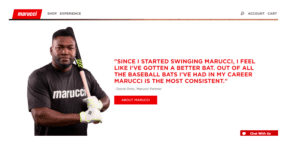Customer testimonials matter. A lot.
Not only do they let you know your brand is doing a good job – they let your prospects know that, too.
Which is why it’s increasingly important to use those testimonials in all right ways. And in this post, I’ll show you how.
How Customer Testimonials Impact Buyer Decisions
To properly understand how to best use testimonials to your benefit, we need to talk about where they come into play for the customers.
First, let’s get this little statistic out of the way: 91% of consumers read online reviews when searching for local businesses.
Just to be clear – that’s almost everyone.
Here’s another good one: 84% of consumers trust online reviews as much as personal recommendations.
So, almost everyone who searches for your product or service will read reviews, and they’ll trust what they say.
These are pretty big numbers, and you may be wondering why the masses are so willing to trust the words of strangers.
The answer is straightforward: social proof. Social proof reinforces that we’re making the right decisions, based on what others have experienced in the past.
If someone has already tried a company and reported a good experience, we’re far more likely to trust that company ourselves.

Customer Testimonials

Customer Testimonials
Based solely on the principle of social proof, testimonials can help do the following:
- Highlight key benefits of your product
- Address and overcome common objections
- Increase your credibility and trustworthiness
- Tell your customer story (a big part of your overall brand story)
Sound good? Great. Let’s get started.
But Wait, There’s More: The Many Benefits of Customer Testimonials
Collecting customer testimonials has an undeniable impact on buyer decisions, but there are a few other benefits we need to talk about.
1. They increase click-through rate (CTR)
Trying to entice a prospect to click?
A few good testimonials should do the trick.
In a study with Google, BrightLocal found that 5-star ratings boost search CTRs by 28%.
2. They raise conversions
Even better, good testimonials extend beyond a click. They’re well-known for helping to increase conversions.

Customer Testimonials Raise Conversions
Power Reviews conducted a study into the reviews of one of their clients to compare the conversion rate between high and low priced items.
The result? Yes, lower priced items still convert well, but expensive items that were given customer reviews saw a 380% increase in conversion rate, compared to a 190% increase in conversion rate for the lower priced items.
3. They boost lead generation (even for B2Bs)
In the battle between case studies and user reviews, user reviews win every time.
Why? Because many users find case studies to be “fairy tales” and “propaganda,” full of “sales spin” or even “fabricated,” according to a study conducted by TrustRadius.
In fact, in a direct comparison, “buyers said reviews were more authentic, trustworthy and balanced than case studies.”
Not only that, but survey takers also responded that client testimonials were described as impacting multiple stages of the buying process as well as being more personal and reflective of the real-world experience.
4. They can boost SEO
Reviews and testimonials can have a major impact on your overall SEO – especially for a local business.
According to MOZ’s Local Search Ranking Factors Survey, online reviews are thought to make up 10% of how Google and other search engines decide to rank search results.
How to Get (Good) Customer Testimonials
Customer testimonials are a form of review.
But there’s on big difference: you seek out the testimonials.
Rather than relying on sites like Yelp to collect reviews, businesses have to do some of the heavier lifting.
But here’s the good news: 7 out of 10 consumers will leave a review if the business just asks them to.
The asking isn’t all that hard, especially if you have a dedicated system in place.
One of the best ways to do it is through a drip email or SMS campaign, designed to follow up with customers right after a purchase and follow up again in the future.
Luckily, there are dozens of review generation platforms designed to automate the process for you.
But remember, half the battle is getting a good customer testimonial.
Simple responses like “great product” and “love it” are a dime a dozen, and won’t be as beneficial to your business.
With that in mind, it’s important to outline the information you want in your testimonials.

Customer Testimonials: Outline the Information You Would Like Included
So ask questions. Ask your customers to talk about the benefits of your product and how it saved them time, money, etc.
And, depending on your industry, ask to use the reviewer’s name and job title with the testimonial. Especially in a B2B industry, this will lend itself to your credibility.
Also, remember that you’ll likely get some bad with the good. And that’s okay – too much feedback can look suspicious. If you do receive negative feedback, use it as an opportunity to employ some top-notch customer service. Reach out to them and work to solve their problem, and you may be able to spin it into a positive review in the end.
Outside of straight-up asking, there are a few other ways to garner great testimonials.
A big one is through social channels.
If you’re set up as a local business and not using your Review tab on Facebook, you’re doing it wrong.
Just kidding – but you could be doing better.
Local Pages come with a dedicated review tab, so if you simply feature it in your visible tabs and direct customers there via email, blog, etc., you’ll find yourself with a few more reviews on hand.
Another great option is LinkedIn and their recommendations. These can be a great source for testimonials – especially for B2Bs.
Of course, they’re only available at the individual level, but by actively encouraging employees to be active on LinkedIn, they may receive reviews that could be used for company testimonials.
How to Use Customer Testimonials
Once collected, it’s time to put those shiny new testimonials to good use. Here’s how:
2. Create a Dedicated Page
Perhaps the most obvious place for great customer testimonials is on its very own reviews or testimonials page.

Customer Testimonials: Add a Testimonials Page
It provides easy directions for customers and having its own page can make searching for reviews on Google, etc. easier to find.
Also, consider adding a few select testimonials to any products or services pages to enforce the credibility of that particular product or service.
3. Use Them With CTAs
Want more people to follow through with your CTA?
Include a few relevant testimonials.
For example, if your goal is to get more people to download your ebook, including a few reviews about how it’s helped people in the past or why your business is so authoritative on the subject covered will help give prospects that needed extra push.
Just remember, context is everything. Don’t include a testimonial about how great your graphic design department is in an ebook about copywriting. Instead, make sure the review lends itself appropriately to what you’re trying to sell.
4. Turn Them Into Case Studies
People love reviews, sure. But what they really want are results.
So prove that you can deliver by using real-life testimonials to support your claims.
You can do it like Nerd Fitness did and craft customer’s results to form your studies:

Customer Testimonials: Use Them for Case Studies
Or, you can get even more creative. The cool thing about testimonials is they don’t have to come in any one single form or fashion.
Just ask Kayla Itsines, one of the top fitness icons in the world, who got her start posting before and after pictures of clients on Instagram.
Flash forward a couple years, and she’s sitting on top of a fitness empire with an extremely dedicated fan base – which still consists largely of real results from real clients.
The takeaway is this: a testimonial can take many shapes and forms, depending on what your audience is most receptive to.
4. Highlight Them on Your Blog
This one’s a little more unorthodox, but no less effective.
There’s a couple of ways to go about this one. First, you can throw in a relevant testimonial in specific blog posts (that relate to each other, of course).
Or, you can do it like Zapier did and hit ‘em with the testimonials first thing. Before the list of blog posts, they include a section of straight testimonials about how great their blog is.

Customer Testimonials: Add Them to Your Blog
-
Use Them in Emails
Get more out of your emails by including testimonials.
Use them to support the products or services you’re trying to sell, but remember – they have to meet the same objective your email is trying to achieve.
Does it address a common problem your target audience has, and how your product helped the reviewer overcome it? Then it just might be the perfect testimonial.
Just make sure you’re not including unrelated reviews, and don’t throw in a review just for the sake of having a review.
Focus on finding testimonials that address common a issue. A testimonial that reaffirms the value of a product or service will help persuade prospects that your company can help them overcome those issues (or reinforce that they were unfounded in the first place.)
6. Social Media
As a primarily user-focused space, social media is a great place to include customer testimonials.
Share testimonials alongside your regular content (remember – nothing to salesy on social media!) and use it to beef up your social media ads.
It’s also a great place to really narrow down to your target audience. For example, if your target audience is new mothers, find a testimonial from a young mother and boost it using the advanced targeting options of Facebook, etc. to make sure it lands in front of the right eyes.
7. Repurpose Your Influencer Marketing Content
We’ve been talking about influencer marketing a lot lately because frankly, it works.
And at its core, influencer marketing is a just a way of collecting a killer testimonial – from someone with a mega large, engaged following.
Targeting and partnering with the right influencers, of course, is half the battle (more on that here,) but once you’re good to go, you’ll have a goldmine of content to pull from.
Take Marcucci. They partnered with major baseballer David Ortiz and included his review right on their homepage.

Customer Testimonials: Repurpose Your Influencer Marketing Materials
Another really cool aspect of influencer marketing is that it often encourages customers to share their own testimonials. Whatever the influencer is talking about or using is something their audience will chime in on as well, so always monitor all incoming comments to find even more testimonials and reviews.
Of course, if you are using your influencers review elsewhere, remember to give them proper credit.
Start Using Customer Testimonials Today
Customer testimonials can be a huge factor in your overall conversion rate.
Not only that, but they have a major impact on how your brand is viewed overall.
Which means they shouldn’t live solely on your “Review” page. Instead, experiment with different ways to incorporate your testimonials to make the most out of each one.


